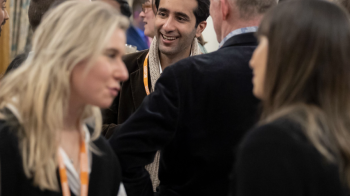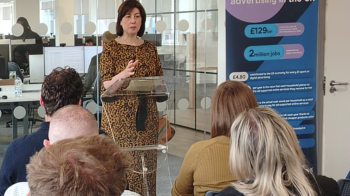What audio ad opportunities are there in gaming?
Posted on Tuesday 31 May 2022 | IAB UK
AdTonos, AudioMob, DAX at Global, Odeeo, NumberEight and Spotify explain how harnessing audio can help take gaming ads to the next level
As part of The Drum’s Deep Dive into gaming advertising, a selection of IAB UK members – including AdTonos, AudioMob, DAX at Global, Odeeo, NumberEight and Spotify – explore the potential of in-game audio advertising for brands. You can find the original version of the article here and unabridged versions of the comments below.
Paul Cranwell, VP of Strategic Partnerships, AdTonos
When was the last time your job really excited you? For me, it’s right now. Audio is having a revolution and none-more so than in mobile gaming. For marketers, in particular, it opens the door to new audiences and great targeting - including hard to reach audiences such as Gen Z, millennials and the over 50s. App Annie forecast 3.2 billion people will be playing games on their phones by 2023 globally and we expect explosive audio ad growth to continue over the next two years as more and more publishers integrate audio alongside video.
Audio ads are delivering high response levels - adding to the users’ experience and not interrupting game play. New innovation is also playing a big role as companies like us roll out new targeting capabilities and voice-activated response technologies.
Radio has for years been the dominant audio player, but gaming will start to challenge that position and attract new advertiser brands. For me, gaming accelerates audio’s credible brand-safe strengths and reputation and helps position it as the perfect alternative and complement to video.
Sally Keane, Head of Enterprise Sales, Northern Europe, Spotify
The huge potential to create immersive, engaging content that resonates deeply with users is what makes in-game audio ads so exciting. With game consoles now the main media and entertainment system for many people, console streaming rates are continuing to increase on Spotify. Music and podcasts have become an integral part of the gaming experience, and users are turning in droves to the personalisation of the experience.
Spotify recently became the first music-streaming brand to have a presence in Roblox - a virtual universe where users can create and play games and share experiences with friends - with the creation of Spotify Island, which has opened doors for how gamers can interact and engage with audio streaming. This will allow artists to connect with fans and partner with Spotify on the creation of in-game virtual merchandise. The first themed experience is coming soon in K-Park, an homage to all things K-Pop.
As the video game industry continues to grow at a breakneck speed, there’s enormous potential for brands to reach this leaned-in, attentive audience. The gaming audience is no longer ‘niche’, it covers a wide array of interests and affinities that allow brands from across the fashion, food, and sports worlds to partner with specific games like Fortnite and Animal Crossing to tap into their target audiences with relevant content. At the same, gaming is no longer just for the younger generations. Adults over 35 have steadily increased their monthly game console streaming time, meaning brands need to rethink relying on traditional channels to reach this demographic and start factoring in the streaming-while-gaming moment into their digital marketing plans.
Christian Facey, Founder & CEO, AudioMob
Audio has always been tremendously important in games, and not just in terms of all the work it does to set tone or atmosphere. It excels in anchoring players in digital spaces, making those places feel more immersive and even tangible.
Today, that core ability of audio to deeply connect with users remains its greatest power. Technological advances simply mean we can now do so much more with that power – look to the popularity of artists like Ariana Grande performing concerts in Fortnite as a captivating example of what’s now possible. Equally, audio excels in cutting through today’s visually cluttered world, deftly grabbing attention without intruding on gaming experiences.
So whatever form the metaverse does take, audio won’t just be key in giving players a sense of presence and direction – it will also let brands, content creators, broadcasters and more connect with vast audiences. Elsewhere, as more games across console, mobile, PC, VR and AR become persistent, connected spaces, we’ll see more musicians, labels, podcasts, advertisers and broadcasters use audio find and engage new audiences.
Essentially, audio now provides a direct channel into the heart of video games, where it can effortlessly, effectively engage any of the 3 billion people that play games today. And as big tech starts to pour ever more money into gaming – see Microsoft’s $68.7 billion acquisition of Activision – the opportunity is only going to grow.
Emma Raz, Director of Commercial, NumberEight
Audio-in-game refers to showing audio ads inside mobile games. What makes audio-in-game so exciting is that it combines two distinctly unique content types - audio and gaming - both known for high session lengths (15-23 minutes per user). Not unlike audio, gaming has very engaged audiences.
Games have traditionally struggled to strike a balance between showing enough ads for effective monetisation while not alienating players. Audio ads present a unique opportunity to add more ad placements without disrupting the actual gameplay. Innovative start ups such as AudioMob, Odeeo, AdTonos, and even established players such as TargetSpot, are making strides to bring this technology to advertisers.
As with any exciting innovation, some challenges lie ahead. For example, audio advertisers have traditionally been targeting users based on personas or capabilities such as day-part targeting to reach users in contextually relevant moments. However, game developers often don’t collect such granular data.
NumberEight has partnered with audio-in-game providers to deliver privacy-first contextual data to help audio advertisers better understand who are the people playing games. In the latest research conducted by NumberEight on three mobile games, contextual data showed that there were 36% desk jobbers, 35% interrupted workers, 26% vehicle users, 21% homebodies and 20% night owls.
Mark Halliday, Director of DAX at Global
Mobile gaming is massive. The IAB says nearly 2 out of 5 people (38%) play a game on their phone every day and it’s on the rise, jumping 29% in the past two years alone. And it’s all sorts of games - Candy Crush, Clash of Clans, Sudoku and even Wordle which recently took the world by storm and spawned hundreds of similar games. This highly engaged audience is also very open to advertising, with the majority (63%) saying they are willing to accept ads in exchange for a free game.
So why are we excited about in-game audio advertising? It provides advertisers with new opportunities to reach broad audiences in new, creative ways. In-game audio ads are also very different to other mobile advertising formats - they’re non-intrusive and they allow gamers to play and listen simultaneously without interfering with game play.
Here at Global, via DAX (our Digital Ad Exchange), we know that we can connect brands with audiences at scale across all audio. Mobile gaming is next on the horizon and we’re ready for this innovation.
Amit Monheit, Co-Founder & CEO at Odeeo
In-game audio advertising is going to completely level the playing field for brands across the world. The gaming industry – particularly mobile gaming – is an absolutely colossal market, hitting over 3 billion players worldwide. But the advertising on it is mostly dominated by other mobile games. So this is a real opportunity for large enterprises – the typical Fortune 500 companies – to finally break into this space and get in front of new customers. And it’s not just that stereotypical picture of a gamer that brands will be able to reach: According to Facebook Gaming, 48% of the world’s mobile gamers specifically are female and, while 16 to 24-year-olds are most likely to game, nearly a third of people that play mobile games are over the age of 45. This is a massive opportunity for brands.
Large organisations already know how to create audio adverts that work. Since the radio first came out, brands have been playing around with the medium and making extremely creative ads. This is their ballpark: they know the rules, they know the techniques and they’ve already got the assets. They could even easily repurpose their content and give it new life.
But it’s more than that. Because it’s a game, you know so much more about the potential listener. So you can target your ads much more effectively than you ever could with other digital audio channels. You get the best of both worlds. All without getting in the way of the actual game, which keeps the players happier, too. That’s pretty damn exciting.
Related content
The IAB Tech Lab projects publishers should know about
Learn moreAll roads lead to Manchester
Learn moreRetail, tech & finance lead agencies’ digital spend in 2024
Learn moreSpotlighting digital advertising’s power at Parliament
Learn more
Fast forward to 2030 with Futurescape
An in-depth exploration of the attitudes, innovations and media shifts that will shape the years ahead and redefine how we advertise by the turn of the decade



